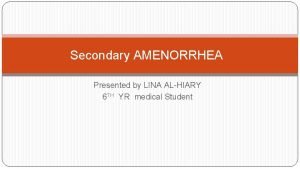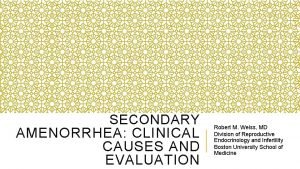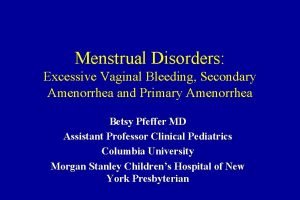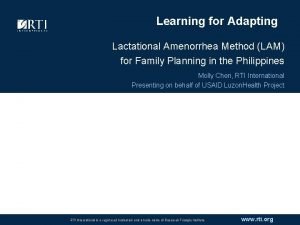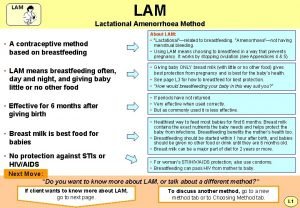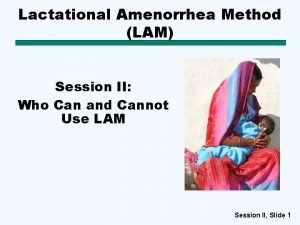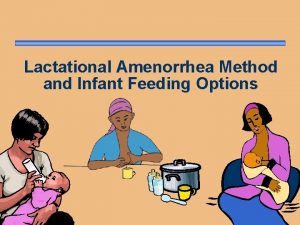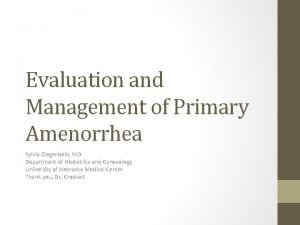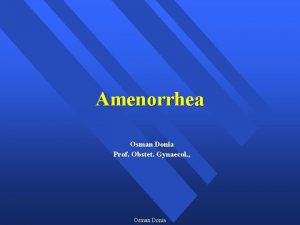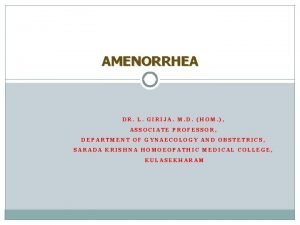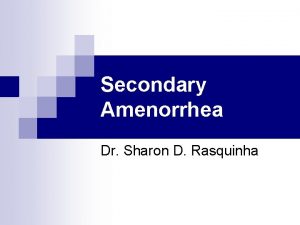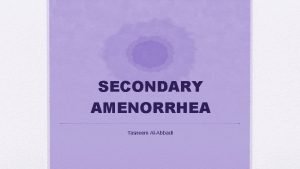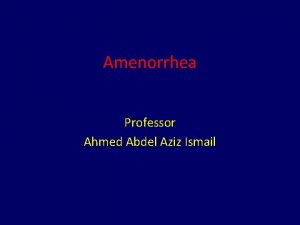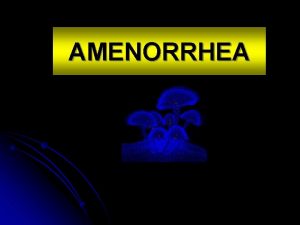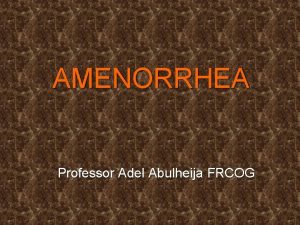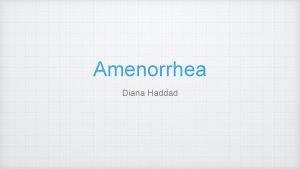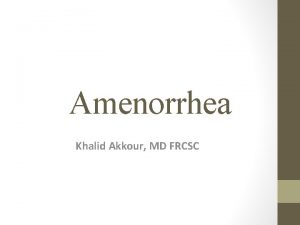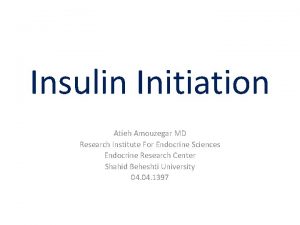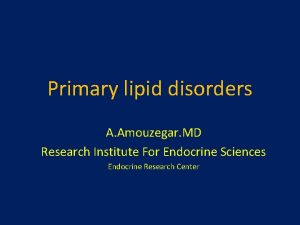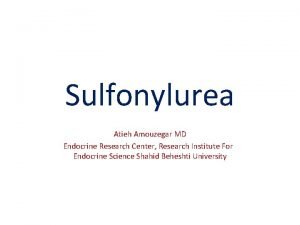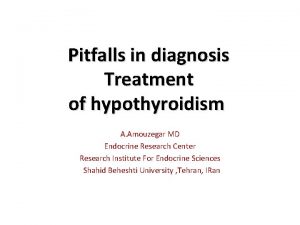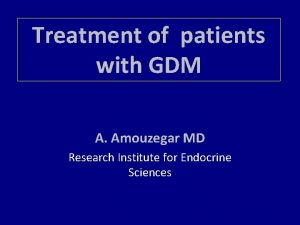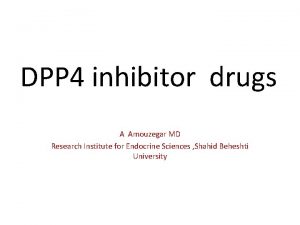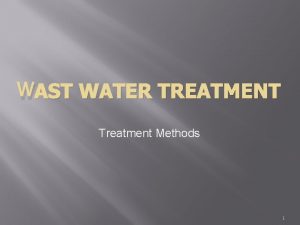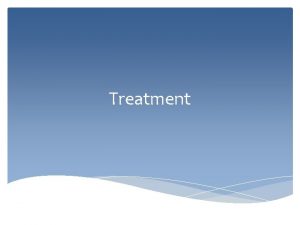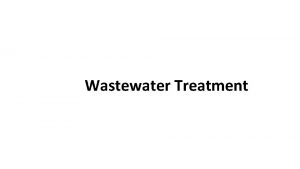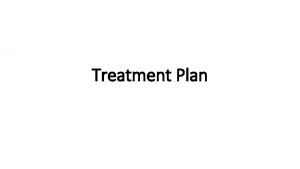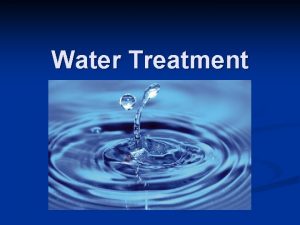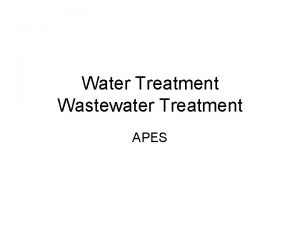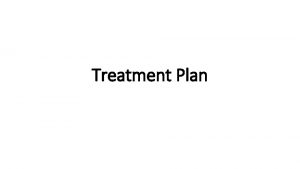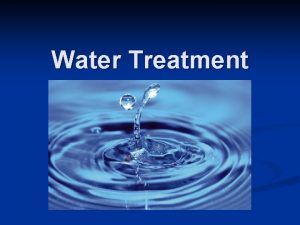Treatment of amenorrhea A Amouzegar Research Institute for









































- Slides: 41

Treatment of amenorrhea A. Amouzegar Research Institute for Endocrine Science 13 Aban 97 Tehran

Objectives • • • Why HRT Type of preparations How to begin Treatment side effects How to follow up Conclusion

Introduction • In girls with hypogonadism the optimal ERT route, dose and dosing tempo should be individualized. • No consensus regarding optimal approach.

Why HRT? • In contrast to postmenopausal women in their fifties and older, the need for HRT in younger women with amenorrhea extends beyond the need for symptom relief. • Protect against serious morbidity and earlier mortality related to prolonged estrogen deficiency.

Need Estrogen • Estrogen’s direct effects on the cardiovascular system Protection: v. Acceleration of endothelial cell growth v. Inhibition of vascular smooth muscle cell growth v. Increase nitric oxide, leading to vasodilation, and prevention of ischemia v. Decreasing total cholesterol and LDL, and increasing HDL v. Vasodilation • Otherwise premature atherosclerosis

Cond’t • Estrogens are essential for bone health • variety of actions in the brain • Effects on skin

The aim of treatment • Allow the development of secondary sexual characteristics (particularly breast). • Allow the growth of the uterus to an adult size and shape. • Achieve a good adolescent growth spurt. • Achieve normal peak bone mass by late 20’s. • Support psychological maturation and adjustment. • long-term medical conditions are associated with a higher prevalence of psychological and mental health difficulties.

NOT OCPs!! • The main goal of HRT for women with primary amenorrhea is to mimic normal physiological endocrinology with regard to estrogen replacement. • Ocps contain the potent synthetic estrogen (EE), which in effect provides more steroid hormone than is needed for physiologic replacement, with unfavourable effects on lipid profile, on haemostatic factors and with an increased risk of thromboembolic events.

Existing evidence • As a consequence of the sparse evidence, recommendations for HRT in amenorrhea must necessarily be based on: v Theoretical knowledge about physiology and endocrinology, and extrapolated from the evidence of HRT in normal menopause. v Thus recommendations today are primarily based on “best clinical practice” supplemented by evidence where it exists.

Patient preference • Patient preference is important for compliance and must therefore be taken into consideration when prescribing. • Continue treatment up to age of normal menopause to maintain feminization and prevent osteoporosis.

HRT in young adolescent • Phase 1: Induction breast development • Phase 2: Induction of menses • Phase 3: Long term maintenance of normal estrogen state

• Type of preparations

Estrogens • There are 3 types of estrogen that are available for hormone replacement: • Estradiol (the main ovarian estrogen 17βestradiol is the active component) • Ethinylestradiol (a synthetic estrogen) • Conjugated equine estrogens (CEE - derived from pregnant mare urine)

eight carbon side chain on carbon-17 of ring D side chain on carbon-17 Cyclohexane A, B, and C rings cyclopentane D ring two angular methyl groups at the junctures of the A: B (carbon-10) and C: D rings (carbon-13).

Estrogens


Conjugated estrogen • Conjugated estrogens (CEs), or conjugated equine estrogens (CEEs), sold under the brand name Premarin (a contraction of "pregnant mares' urine") • contains a mixture of estrogen hormones • Estrone sulfate (50 -70% of total) • Equillin sulfate ( 20 -30% of total)

Conjugated Estrogen Equilin sulfate Estrone sulfate, Esterone sulfate is easily absorbed into the blood and can be converted to estradiol.

Route of administration • • Orally Transdermal patches and gels Estrogen-releasing vaginal ring Estrogen-based vaginal creams and pessaries Subcutaneous implants Nasal sprays Injectable estrogen preparations( new)

Oral Vs transdermal • The transdermal route can achieve higher plasma levels of circulating estradiol with a lower treatment dose. • The oral route is subject to a high first-pass effect, which results in high levels of estradiol and consequent estrogenic effects in the liver and low potency due to first-pass hepatic and intestinal metabolism into metabolites like estrone and estrogen conjugates. • Conversely, this is not the case for parenteral routes, which bypass the intestines and liver.

Progesterone • E-induced endometrial hyperplasia mandates the addition of a progestogen to the HRT regimen for endometrial protection and cancer risk reduction.

• PUBERTY INDUCTION

Estradiol

Each patch has 8 mg 17β Estradiol and release rate 0. 1 mg /24 h




Progesterone

Comparison of the products • There is no hard evidence to favour the use of either oral/transdermal 17β-oestradiol or oral ethinyloestradiol for pubertal induction. • There are no RCTs comparing final height, normalisation of breast development, cardiovascular risk or patient satisfaction. • However, micronized oestradiol is identical to the natural product of the ovary and is the most physiological form of oestrogen available, and there is a trend towards the use of more natural products.

Daily dose equivalency • 50/100 mcg Transdermal (applied twice weekly and left in situ) = 2 mg oral 17β (per day) = 20 mcg ethinylestradiol (per day). • 0. 625 mg of CE = 1 mg micrinized Estradiol=0. 05 mg transdermal estradiol= 0. 05 mg Ethinyl estradiol • E 2 matrix patch is the first choice of pubertal HRT • Can be cut to achieve physiological E 2 concentration seen in spontanous puberty.

How to start Estrogen? • Although the appropriate starting dose has yet to be determined, estrogen replacement is usually begun at one-tenth to one-eighth of the adult replacement dose and then increased gradually over a period of 2 (to 4 )years. • To allow for normal breast and uterine development. • It seems advisable to delay the addition of progestin at least 2 years after starting estrogen or until breakthrough bleeding occurs.

When and how to start estrogens • Start estrogen supplementation from the age of 12 years in the absence of a spontaneous start or progression of breast development (12 -13 years). • Oral ethinylestradiol and micronized estradiol have both been used for puberty induction. • Puberty is a relatively slow process and the replacement therapy in the induction process should mimic this.

Adult dose • • 100– 200 μg transdermal E 2 2– 4 mg micronized E 2 20 μg EE 2 1. 25– 2. 5 mg CEE

Dosage • phase I • A typical regimen consists of an estrogen with a dosage equivalent to 6. 25 -25 mcg/day of transdermal estradiol (approximately 0. 15/0. 3 mg of CEE) given unopposed (ie, no progesterone) daily for 6 months with incremental dose increases at 6 month intervals until the required maintenance dose is achieved. • Estradiol 0. 25 -0. 5 mg increasing over 2 years to an adult dose of 2 mg. • Ethinyl Estradiol 0. 005 -0. 015 mg /d

Cond’t • Typically, 6 -18 months are allowed in this phase and is individualized depending on patient`s age, pubertal stage prior to start of therapy, height, and response to therapy.

Cond’t • phase II • is the induction of menses. • During this phase, doses of estrogen are further increased. • They suggested use of oral CE (0. 625 mg, daily) or a patch of equivalent strength (0. 025 mge 0. 05 mg, 2*week). • Progestins are added, in general with breakthrough bleeding, and/or when breast development is complete, in a dose of 10 mg per day for 7 -10 days for each month, to induce menses.

Cond’t • Phase III is described as a long term maintenance • Oral Premarin 0. 625 -1. 25 mg daily • Ethniyl estradiol 20 -35 mcg daily • Transdermal patch 0. 075 mg- 0. 1 mg, 2* week) with progestins

Patches • Estradiol comes in the form of a patch which is applied directly to the skin. It then passes slowly into the blood stream through the skin • ‘ 25’ releases 25 micrograms of estradiol every day. • ‘ 50’ releases 50 micrograms of estradiol every day. • May be given continuously if patient does not have an intact uterus or cyclically (3 weeks on, 1 week off) in patients with intact uterus. Rotate application sites.

Regimens • Continuous estrogen replacement • Cyclical regime

Conclusion • • • Treatment should be individualized Mimic normal physiologic Consider patient preference Begin with Estrogen then add progesterone Follow your patient with clinical signs Treatment should be continued till menopause age

• Do not forget psychosocial support!
 Jamshid amouzegar
Jamshid amouzegar Amenorrhea approach
Amenorrhea approach Secondary amenorrhea causes
Secondary amenorrhea causes Primary amenorrhea
Primary amenorrhea Amenorrhea causes
Amenorrhea causes Lactational amenorrhea
Lactational amenorrhea Lam contraception method
Lam contraception method Lactational amenorrhea
Lactational amenorrhea What is lactational amenorrhea method
What is lactational amenorrhea method Boys body
Boys body Progesterone challenge test
Progesterone challenge test 2ry amenorrhea
2ry amenorrhea Amenorrhea
Amenorrhea Ucla autism center
Ucla autism center Formuö
Formuö Typiska drag för en novell
Typiska drag för en novell Tack för att ni lyssnade bild
Tack för att ni lyssnade bild Vad står k.r.å.k.a.n för
Vad står k.r.å.k.a.n för Varför kallas perioden 1918-1939 för mellankrigstiden
Varför kallas perioden 1918-1939 för mellankrigstiden En lathund för arbete med kontinuitetshantering
En lathund för arbete med kontinuitetshantering Kassaregister ideell förening
Kassaregister ideell förening Tidbok
Tidbok Sura för anatom
Sura för anatom Vad är densitet
Vad är densitet Datorkunskap för nybörjare
Datorkunskap för nybörjare Tack för att ni lyssnade bild
Tack för att ni lyssnade bild Tes debattartikel
Tes debattartikel För och nackdelar med firo
För och nackdelar med firo Nyckelkompetenser för livslångt lärande
Nyckelkompetenser för livslångt lärande Påbyggnader för flakfordon
Påbyggnader för flakfordon Arkimedes princip formel
Arkimedes princip formel Offentlig förvaltning
Offentlig förvaltning Urban torhamn
Urban torhamn Presentera för publik crossboss
Presentera för publik crossboss Jiddisch
Jiddisch Vem räknas som jude
Vem räknas som jude Klassificeringsstruktur för kommunala verksamheter
Klassificeringsstruktur för kommunala verksamheter Luftstrupen för medicinare
Luftstrupen för medicinare Claes martinsson
Claes martinsson Cks
Cks Verifikationsplan
Verifikationsplan Mat för idrottare
Mat för idrottare

